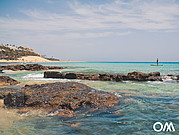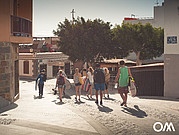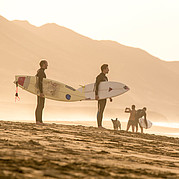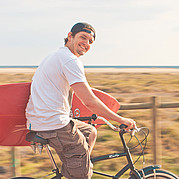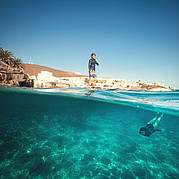Surfing in Jandia at El Pozo surf spot
The southernmost point of Fuerteventura is not - as many assume - at the last end of Fuerteventura, which can only be reached via a gravel road. The southernmost point is at the tip of the Jandia peninsula in front of the lighthouse of the well-known holiday resort of the same name. Here, the long white sandy beaches, for which the south of the island is especially famous, become wider. In addition, the large salt marshes begin here.
On the beach of Jandia in front of the lighthouse, waves do not only break during strong swells on the west coast. The strong trade winds in summer can also form waves to surf here.
The surf spot in Jandia where the wind waves break is called "El Pozo". It is located right in front of the Jandia lighthouse on Fuerteventura. The wind waves at "El Pozo" are often strong enough to surf them with a normal shortboard. Unlike many other surf spots on the south coast and east coast of the island.
For many surfers in the south of Fuerteventura, "El Pozo" is one of the best windswell-generated waves for surfing in Jandia. Especially in summer, this surf spot is very popular.
Directions to Jandia in Fuerteventura
You don't need maps or a navigation system to get to the El Pozo surf spot in Jandia. If you are coming from La Pared, Costa Calma or even further north, simply follow the motorway towards Morro Jable.
At the end of the southern motorway on Fuerteventura, the road becomes a single lane after a roundabout. It then goes under a bridge and down a hill. This is where the two-lane, palm-lined beach promenade of Jandia begins.
The best place to park is in front of the lighthouse. Here you will find a wooden footbridge that leads across the salt marshes to the lighthouse.
Often you only see the waves when you are on the beach directly in front of the lighthouse.
The waves of El Pozo in Jandia, Fuerteventura
As with the other surf spot in Jandia, Cruz Roja, the sandbanks on the beach in front of the lighthouse often change their position and shape over the year.
You can observe this especially in Morro Jable further south. Here the beach is sometimes 50m wide and in other years barely 2m wide. Powerful waves from different directions can wash enormous amounts of sand up and down the coast.
The position and shape of the waves at El Pozo do not change as much as the waves at the neighbouring Cruz Roja beach section due to the shifting of the sand.
The waves in "El Pozo" almost always run from right to left. They are therefore also called "left-hand waves" or "left-handers".
Directly in front of the lighthouse, the wave is usually the hollowest and steepest. Further to the left of the lighthouse, towards the Cruz Roja beach section, the waves break longer and more gently.
The stronger the wind swell, the bigger the waves in "El Pozo". Then the long breaking waves to the left of the lighthouse start to join the steep waves in front of the lighthouse.
Tip for surf pros: In addition to the left-hand waves in front of the lighthouse, there are often short right-hand waves for surfing in Jandia when there is a wind swell. These break very steeply and hollow. Therefore, they are ideal for a few thrilling summer tubes in boardshorts!
In which conditions do you surf at El Pozo in Jandia?
As with all other wind waves on the east and south coast of Fuerteventura, the basic requirement is strong wind. It must blow constantly for several days. Spring and summer are the seasons when these strong winds occur frequently. This is where the name Fuerteventura comes from, because in German "fuerte" means strong and "ventura" means wind. Fuerteventura therefore translates as "strong wind".
To ensure that this strong wind also builds up waves, the direction is decisive in addition to the strength. The best direction is when the wind comes from the north-east. Then there is a special phenomenon for the waves on the south and east coast. The strong wind creates waves and, thanks to the geographical orientation of the southern peninsula, the same wind is offshore directly on the beach. This means that the wind waves in the south of Fuerteventura are small due to the offshore wind, but at the same time they are very clean. This makes them much better to surf.
If the wind comes too northerly, the waves do not reach the east and especially the south-east coast of Fuerteventura. If the wind is directly from the east, it also creates waves, but these do not break in offshore winds.
In this case, however, the wind on the west coast of Fuerteventura is also offshore and the waves break better at La Pared surf spot. As you can see, you can always find good waves for surfing somewhere on the island of Fuerteventura.
In El Pozo, you can surf at low to medium tide. At high tide you can surf here only in rare cases. At low tide, you can also surf in the white water in "El Pozo", directly in front of the lighthouse or to the left of it.
What should you look out for when surfing at El Pozo in Jandia?
In contrast to other beaches, there are no dangerous cliffs or stones in the water at the beach section of "El Pozo" in Jandia, just like at "Cruz Roja". The current here is also relatively low and therefore rather harmless.
This slight current permanently pulls surfers parallel to the coast from north to south, which means down towards Morro Jable. It is caused by the wind waves that hit the beach at a lateral angle. Since the current runs parallel to the beach and does not go out to sea, it is not really dangerous. However, it can happen that the current pulls you into the steeper part of the wave, which may not yet suit your surfing ability. The current is strongest in shallow to waist deep water, close to the beach.
The steepest and also most powerful part of the wave breaks directly in front of the lighthouse. This is probably the only factor that inexperienced surfers should pay attention to on this surf spot.
While experienced surfers love this section of the wave, beginner surfers can be thrown quite violently and hard onto the flat sandbank or directly onto the beach.
Especially in summer, these high and steep waves, which are especially popular with the locals, do not break in many places. Therefore, on some days, the last wave section of "El Pozo" can get crowded.
If you are not looking for small tubes and vertical turns with your shortboard, you can safely avoid this wave section. In that case, you're better off surfing the gentler waves that run only a few metres to the left on the beach.








